-
Pros
- Simple interface.
- Syncs projects across devices.
- Good color and title tools.
- Easy sharing to social networks.
-
Cons
- Short on video effects.
- Limited transitions.
- Requires subscription.
- Expensive if you're not already a CC subscriber.
- Can't specify output file format.
- Slow rendering.
- No storyboard templates.
Adobe now has three video editing software options: Premiere Pro for the pros, Premiere Elements for the hobbyists, and Premiere Rush for the vloggers and social media posters. Having started life as a mobile-only app, Rush now offers a desktop app. As the product name suggests, the whole idea behind Rush is to get from shooting to editing to sharing fast. We found that its simple interface and workflow lends itself well to those goals. Rush is worth a look for any social video creators.
How Do You Get Adobe Premiere Rush?
Rush doesn’t require a full Adobe Creative Cloud subscription or even a Premier Pro subscription, though you do get Rush if you have one. In fact, you can use Rush for free on mobile, if you don’t care about the 2GB cloud storage limit. That amount doesn’t cut it for longer or higher resolution video such as 4K. Using Rush on the desktop does require a subscription, unlike the buy-it-once Premiere Elements. For just Rush, you pay $9.99 per month, which gets you 100GB of cloud storage.
The app is available for Android, iOS, macOS, and Windows 10. Unfortunately, it’s not a store app for either desktop platform, which eases installation, especially on the Mac. On Windows, I was required to install Rush using the Creative Cloud desktop app, though on Mac I could download the DMG. On Apple mobile devices, the app requires iOS 13 or later and a device with an A9 ARM chip or higher. On Android devices, it requires at least Android 9 and certain devices from Samsung, Google, OnePlus, Sony, and Xioami. On Windows, you need a 64-bit CPU running Windows 10 version 1903 or later, and on a Mac you need macOS 10.14 or later; Apple M1 CPUs are supported.
How Do You Use Adobe Premiere Rush?
The phrase easy video editing has long seemed an oxymoron to me. Most of the tools I’ve tested that promise no-effort video editing produce unimpressive, imperfect results. Rush doesn’t take all the effort out of creating high-impact social videos, but it does give you the tools you need in a simple, clear package.
The simplicity starts with creating a new project: You get going by tapping the plus sign. Then, if you’re on mobile, you choose whether you want to start shooting video or to select clips from your camera roll for the new project. All major formats are supported, though Rush doesn’t let you edit 360-degree VR footage. As you tap on clip thumbnails to add them to the project, they’re overlaid with big 1,2,3 etc. to show their position in your movie. You can create a project from clips on your desktop computer, but the real selling point of Rush is to start with your smartphone and proceed from there.
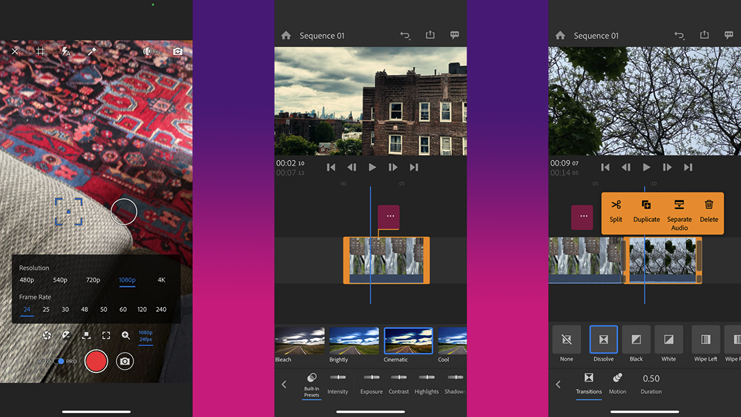
The camera interface on mobile is excellent, with a welcome choice between automatic and manually controlled shooting. For example, you can have both lighting and focus either automatic or manual. You can also choose the resolution and frame rate, as you can see in the screenshots. As with most specialized camera apps, Rush lets you tap the screen to indicate which parts of the frame should determine focus and exposure.
You get a choice of four aspect ratios for your project: 16:9 horizontal or vertical, 4:5 vertical, and square. I think this should be a choice when you first start a project. You can choose the aspect ratio at the start if you’re working with existing content, from the gear icon in the import page. If you tap the preview button in the source panel, you can trim the clip, even using the traditional I and O keyboard shortcuts.
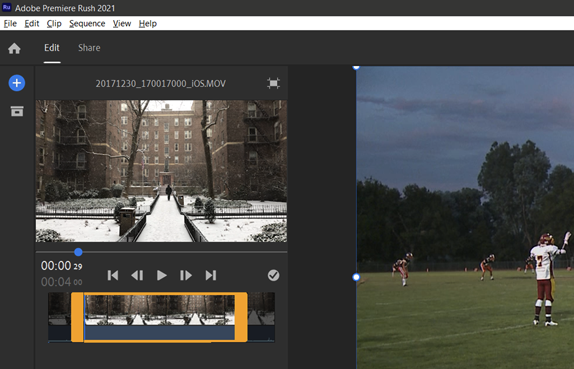
You can also turn on Auto Reframe, which attempts to keep what’s important in frame if, for example, you shot wide horizontal, but your output is vertical or square. For one test project, when I used existing clips shot on my iPhone, the images didn’t rotate as expected, and sometimes got stretched. When you shoot within the app, this is never a problem. iMovie (as well as the video editing feature in the free Microsoft Photos app that comes with Windows) makes it super simple to rotate a video from vertical to horizontal with a twist gesture.
On the desktop, you can move the timeline with the mouse wheel, and expand or contract it with Alt-mouse wheel, but you can’t move forward and back with the arrow keys. You can start and stop playback with the spacebar or the J, K, and L keys (back, pause/play, forward). When you hover the mouse cursor over most buttons, a helpful box pops into view explaining what it does and how to use it. The interface is not particularly customizable, but you can make the video preview window bigger or smaller relative to the timeline.
The timeline features one main video track, with the ability to add three overlay tracks above that and three audio tracks below it. You can hide the trackhead controls, which makes the interface resemble Apple iMovie and Final Cut Pro’s trackless timeline. It took me a little while to figure out that I could actually drag clips or images above the main track to create picture-in-picture overlays.
Polishing and Perfecting Your Video
As in any video editing app, you can trim and split the clips, apply simple transitions, add graphics with text, apply color effects and lighting adjustments, edit the sound, change the video speed, and crop and rotate it. You can do all of this in either the mobile or desktop app, though the larger workspace of the desktop is better suited to this kind of work. Apple, in its comparable iMovie app, doesn’t include all the features in its mobile version, leaving things like green screen (which Rush lacks) and picture in picture to the desktop version alone.
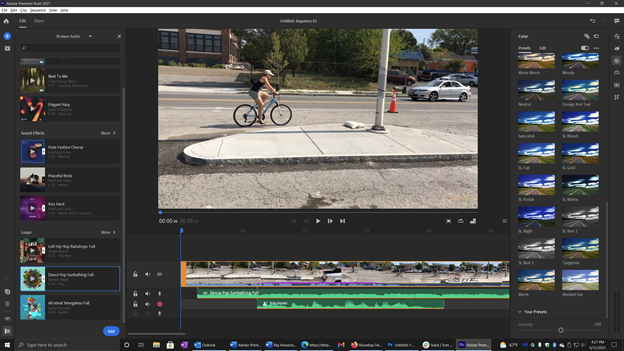
There are 35 color effect filters à la Instagram that you can apply to your movie, and a slider lets you increase or decrease their strength. Apple iMovie includes more-drastic and fun filter options, as well as themes and trailer templates—all of which Adobe Rush doesn’t match. Rush also lets you adjust exposure, contrast, highlights, shadows, and color parameters—just like in a photo editing application. Sharpening, a Faded Film effect, and Vignetting tools round out the image processing tools.
Transitions
You don’t get a wide variety of transitions—none of the fun, crazy ones you see in most consumer video editing applications. What you get is a choice of 16 dissolves, wipes, slides, and pushes. When you add one of these to a clip intersection by dragging it, it’s not very clear that you’ve added it on the timeline, but, in testing, the transitions had been applied and worked as indicated. You can change the duration of a transition, but I wish there were a way to apply them to all component clips at once.
Titles
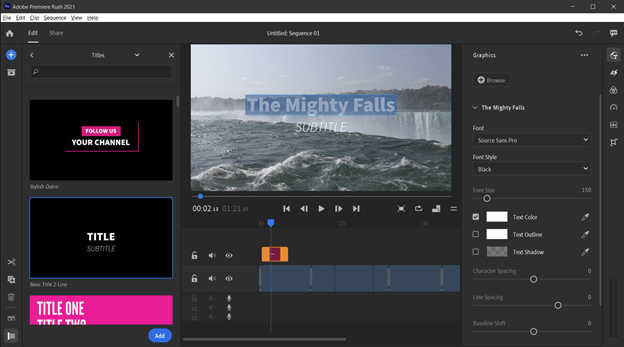
Title options were far more generous than I expected for such a streamlined app. You access this from the top button on the right panel, called Graphics. This one button accesses Titles, Transition Graphics, and Overlays. The titling feature lets you use WYSIWYG to position and resize the text in the frame. You get a large selection of fonts and a color picker lets you customize the hue and tint to your heart’s content. Many of the templates include animation, giving your titles extra life. Working with text is one of the tasks that’s especially easier on the desktop than on a phone, but if you’re pressed, you can do it all on the smaller screen, and the clear interface makes it tolerable.
Working With Sound
The Audio panel lets you add from a decent selection of background music, sound effects, and loops. You can also add a music file of your choice for background and change clip volume (or mute it). A microphone below the main video track lets you add a voiceover. An Auto Volume checkbox didn’t do anything noticeable in my test video.
Audio is a major limitation of the app: Not only is there no auto-ducking, and you can’t drag down the audio level in the waveform on the timeline as you can in many video editing applications. Forget about effects like changing the type of acoustic for the sound—some let you re-create the effect of a stadium or cathedral. Finally, there’s no audio scrubbing, so you can’t hear sound as your moving back and forward in the timeline.
Time Remapping

As you can see in the screenshot, the Speed tool lets you select a stretch of your video you want to speed up or slow down. A helpful option is Maintain Audio Pitch, and another is Ramp, which applies the speed changes gradually. One missing—and very much in demand—speed effect is freeze-frame, which Apple’s iMovie app does offer.
Output and Performance
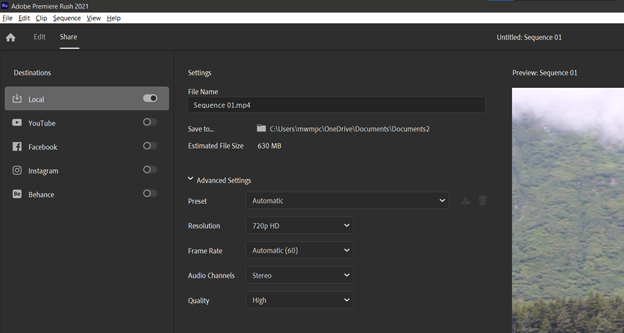
Switch to the Share mode to send your video project out to the world. You can use presets for YouTube, Facebook, Instagram, or Adobe’s beloved Bēhance. Alternatively, you can set custom parameters for frame rate, resolution, and audio to output an MP4 file. You can’t, as you can with most enthusiast video software, choose a file format or codec.
The most powerful output option, though, is to open your Rush project in Adobe Premiere Pro, which includes an option for just that on its home page. Once you do that, any limitations mentioned elsewhere in this review vanish. Rush projects open in Premier Pro as if they were built in it, with all your tracks (both video and audio), edits, effects, and clips in place.

Since the app doesn’t include the standard transitions I use in my rendering test, I won’t make a direct comparison with other video editing software here, but my test project without the same transitions I normally use took 1:15 (min:sec), which is not bad at all. I will say that using the app was delay-free (except for when loading project content from the cloud), even after applying something fairly demanding like picture-in-picture or time remapping.
Are You in a Rush to Make Videos?
As its name implies, Rush can get you from shooting to sharing in two shakes of a selfie stick, and there’s certainly enough editing capabilities in the app to cut a decent-looking vlog, with titles, transitions, and audio edits. But many YouTubers will want more advanced capabilities like those possible with fuller-featured desktop video editing software. For loads more video tricks and tools, look to Editors’ Choice applications like Corel VideoStudio, CyberLink PowerDirector, and—if you’re at the professional level—Adobe Premiere Pro or Apple Final Cut Pro.

